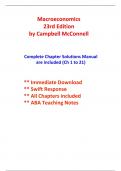Macroeconomics
23rd Edition
by Campbell McConnell
Complete Chapter Solutions Manual
are included (Ch 1 to 21)
** Immediate Download
** Swift Response
** All Chapters included
** ABA Teaching Notes
,Chapter 01 - Limits, Alternatives, Choices
Chapter 01 - Limits, Alternatives, and Choices
McConnell Brue Flynn 23e
DISCUSSION QUESTIONS
1. What is an opportunity cost? How does the idea relate to the definition of economics?
Which of the following decisions would entail the greater opportunity cost: allocating
a square block in the heart of New York City for a surface parking lot or allocating a
square block at the edge of a typical suburb for such a lot? Explain. LO1.1
Answer: An opportunity cost is what was sacrificed to do or acquire something
else. The condition of scarcity creates opportunity cost. If there was no scarcity,
there would be no need to sacrifice one thing to acquire another. The opportunity
cost would be much higher in New York City as the alternative uses for that
square block are much more valuable than for a typical suburban city block.
2. Cite three examples of recent decisions that you made in which you, at least
implicitly, weighed marginal cost and marginal benefit. LO1.1
Answer: Answers will vary, but may include the decision to come to class, to
skip breakfast to get a few extra minutes of sleep, to attend college, or to make a
purchase. Marginal benefits of attending class may include the acquisition of
knowledge, participation in discussion, and better preparation for an upcoming
examination. Marginal costs may include lost opportunities for sleep, meals, or
studying for other classes. In evaluating the discussion of marginal benefits and
marginal costs, be careful to watch for sunk costs offered as a rationale for
marginal decisions.
3. What is “utility” and how does it relate to purposeful behavior? LO1.1
Answer: “Utility” refers to the pleasure, happiness, or satisfaction gained from
engaging in an activity (eating a meal, attending a ball game, etc.). It is an
important component of purposeful behavior because people will allocate their
scarce time, energy, and money in an attempt to gain the most utility possible.
4. What are the key elements of the scientific method, and how does this method relate
to economic principles and laws? LO1.2
Answer: The key elements include the gathering of data (observation), the
formulation of possible explanations (hypothesis), testing the hypothesis,
determining the validity of the hypothesis, and repeated testing of the hypothesis
that have appeared to be valid in prior tests.
1-1
, Chapter 01 - Limits, Alternatives, Choices
The scientific method is the technique used by economists to determine economic
laws or principles. These laws or principles are formulated to explain and/or
predict behavior of individuals or institutions.
5. Make (a) a positive economic statement of your choice, and then (b) a normative
economic statement relating to your first statement. LO1.3
Answer: Answers will vary. Example: (a) The unemployment rate is 4.8 percent;
(b) the unemployment rate is too high. In general, we treat “what is” statements as
positive, “what should be” as normative, but keep an eye out for statements like
“at full employment an increase in the production of pizzas should come at the
cost of less robots.” Some students may incorrectly identify the statement as
normative because of the term “should.”
6. How does the slope of a budget line illustrate opportunity cost and trade-offs? How
does a budget line illustrate scarcity and the effect of limited incomes? LO1.4
Answer: Budget lines are always sloped downward. This downward slope shows
an inverse relationship between the two goods, meaning that as you increase one,
the other must decrease. This decrease is what you are giving up, or the
opportunity cost, of the good you are getting more of.
Budget lines illustrate scarcity in that they show you are limited by your income.
Since they slope downward, they show you cannot keep getting more and more of
both goods. There is always a trade-off. The area beyond the budget line
represents combinations of the goods that are beyond your income.
7. What are economic resources? What categories do economists use to classify them?
Why are resources also called factors of production? Why are they called inputs? L
O1.5
Answer: Economic resources are the natural, human, and manufactured inputs
used to produce goods and services.
Economic resources fall into four main categories: labor, land (natural resources),
real capital (machines, factories, buildings, etc.,) and entrepreneurs.
Economic resources are also called factors of production because they are used to
produce goods and services. They are called inputs because they go into a
production process (like ingredients go into a bowl to make a cake), with the
resulting goods and services also being referred to as output.
1-2




